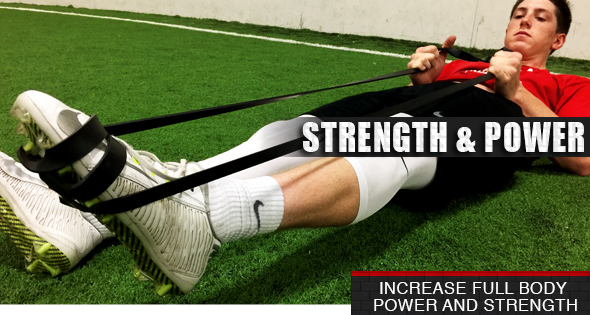Use A Variety Of Different Exercises During Training
Athletes and coaches who implement a wide variety of different exercises will see greater development in athletic skills. Using different exercises that not only challenge different areas and muscle groups but also vary in speed and intensity will allow for greater athletic developments. Slower strength exercises like the Ballistic Bands Reverse Hamstring Curl or the Victory Ropes Hercules Lunges force the athlete to use a high amount of muscle recruitment to build strength and stability as these different exercises are completed. Fast paced exercises like the Victory Ropes Modified Partner Slams or the Victory Rope Spartan Crawls, which focus on power and explosiveness, should also be performed during training sessions.
Performing a circuit style workout that implement multiple exercises like upper body, lower body, and core muscle exercises will challenge athletes cardio strength and help increase performance late into games. Slower upper body, lower body, and core stability exercises performed one at a time can be utilized during training as well. Athletes whose focus is gaining strength should implement a larger number of slow strength training sessions that incorporate lots of different exercises for strength.
Core Stability Exercises: Reverse Lunge Military Press
Athletes who make core stability exercises like the Reverse Lunge Military Press a regular part of their workouts will see advances in agility, explosiveness, and strength in several different exercises.
To perform the Reverse Lunge Military Press athletes will need 1-2 Ballistic Bands. Athletes with two Ballistic Bands should use the one with lighter resistance for their first 1-2 sets of the core stability exercises. This will act as a great dynamic warmup and prepare the body to execute the core muscle exercises. Athletes will then move into using the heavier resisted Ballistic Band. Athletes who use this gradual increase in resistance will see improved performance late into their core stability exercises and strength training.
To execute the Reverse Lunge Military Press athletes will place one end of the Ballistic Band on the ground and place the opposite end in the hand on the same side of their body. Athletes can hold the Ballistic Band in two different fashions, in a neutral grip or with a pronated grip. To use the neutral grip for the core stability exercises athletes will turn the palm so it is facing in toward the body as the Ballistic Band is wrapped around the thumb joint and grasped tightly by the athlete. From this neutral grip athletes will want to keep their elbow directly in front of their body throughout the entire lunging and pressing involved in the core stability exercises. For the pronated grip (palm facing away from the body) athletes will secure the Ballistic Band around the hand, face the palm forward while grasping the Ballistic Band, squeeze the shoulder blades, and keep the hand and arm from falling forward during the press. During both of these holds for the core stability exercises athletes can extend their opposite arm straight out to the side to induce a greater squeeze of the shoulder blades during the Reverse Lunge Military press and many different exercises.
Full Body Core Muscles Exercises
Once athletes have decided on which grip to use for the core stability exercises they will come to a good starting position, step back with one leg while simultaneously pressing their resisted hand to the ceiling. As athletes step back during the core stability exercises they need to maintain their front knee behind their front toes, avoid an over step backwards by stepping back and then sinking the hips toward the ground, and driving through the heel of the front leg. As athletes press up from their lunged position they will drive through their front heel, maintain a squeeze on the shoulder blades and abs, and return to their starting position in a controlled manner. During the core stability exercises athletes need to keep their knee in line with their ankle and hips. Allowing the knee to internally rotate will result in knee pain and possible injuries. To learn how to avoid knee pain and athletic injuries can go to the Recovery Section and learn how to use the Recovery Foam Roller to Roll and Stretch Their IT Band.
Athletes will perform 4-6 sets of 12-14 repetitions on each side of the body. Athletes and coaches should allow 40-60 seconds of recovery between sets of the core stability exercises.
Different Exercises For Additional Strength Training
After, and before, athletes have completed the Reverse Lunge Military Press they need to implement exercises that focus on strengthening the rest of the body. Upper body exercises like the Resisted Upright Row and KB Powerbands Shoulder Progression will allow athletes to isolate and focus on building individual strength in these muscles. Combining the upper body training with lower body strength training exercises like the Manual Resisted Hamstring Curl and additional core muscles exercises will help to develop well-rounded and skilled athletes.
Athletes and coaches can go to the Training Section to learn about additional exercises that can be performed with the Ballistic Bands. While in the Training Section athletes and coaches should explore the different exercises and core stability exercises which can be performed with strength training equipment like the Victory Ropes, Kbands Stability Ball, and KB Duo.
Outside of being great training equipment to complete core stability exercises and a variety of different exercises, Ballistic Bands can also be used to maintain flexibility and mobility in the athletes knees, hips, lower back, shoulders, and elbows. Athletes can go to the Recovery Section to learn how the Ballistic Bands and Recovery Foam Roller can be used to increase athletes’ performance, while limiting or eliminating tightness, soreness, and injuries.
For any additional training questions or to explore different exercises that can be incorporated to create a challenging workout go to the Training Section and start performing drills found in the Strength and Conditioning Section.

